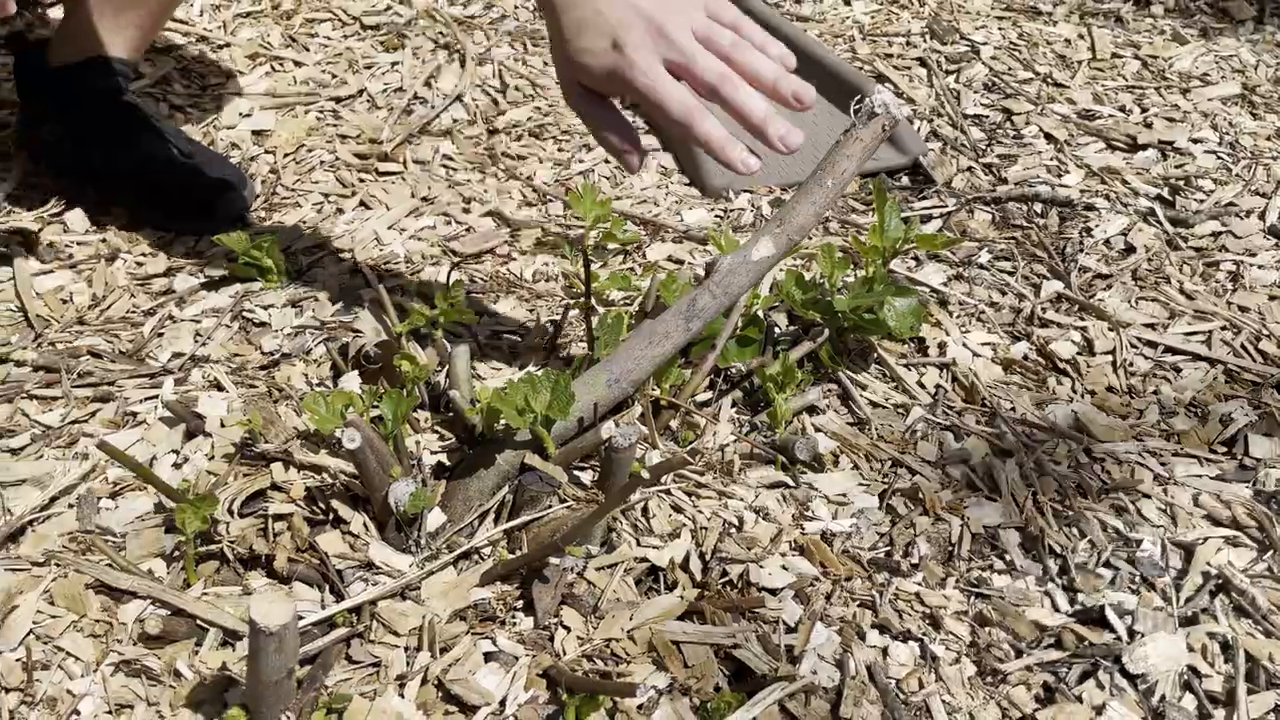Hello readers, today I'm going to be offering you four invaluable tips to maximize fruit production from your fig trees. This advice will be most useful to gardeners in growing zones 5-7, where temperatures are too cool to successfully grow figs as full-sized trees. In these climates, figs are generally grown as bushes.
Tip #1: Prune Your Fig Trees Back to The Ground Annually
The first critical step to maximize your crop is to prune your fig trees back to ground level every year in early spring. As you can see in the image below of my LSU Purple fig variety, I have already cut this bush back to the soil surface. We are now in early April, and new sprouts are emerging across the entire plant.

This pruning accomplishes two important objectives:
-
It removes any dead wood that will not generate new growth and fig production.
-
It shapes the fig into a bush form ideal for colder climates. Fig trees will likely die back each winter in zones 5-7 regardless, so pruning simply accelerates the process in a controlled manner.
Shaping your figs into a bush configuration ensures that all new growth emerges close to the ground, where it is marginally warmer and more protected. This new growth will bear the season's fig crop.
Tip #2: Apply Heavy Mulch Around Fig Tree Bases
The second vital technique for maximizing your yield is heavily mulching around the base of each fig tree with wood chips or other organic materials. Mulching serves two important functions:
-
It insulates the soil and lower branches from extreme cold, helping keep the tree alive and productive.
-
As the mulch slowly decomposes over seasons, it enriches the soil with organic matter and nutrients to feed fig growth and fruiting.
I personally source wood chip mulch from a bulk delivery service called Chip Drop. Their product contains a diverse mix of materials like wood pieces, leaves, and twigs. This variety helps some components, like leaves, break down more rapidly to improve soil conditions. Meanwhile, larger wood chips take longer to decay, providing lasting insulation and moisture retention benefits.
Over the first few years mulching fig trees here, I transformed terrible clay soil into rich, fertile loam that plants thrive in. This exemplifies mulching's long-term soil enhancement capability. Figs will repay this improved soil with bigger harvests year after year.
Tip #3: Plant Figs In Well-Draining Soil
Another prerequisite for productive fig trees is planting them in soil with excellent drainage. Figs can tolerate various soil types, but wet feet will lead to root rot and other fatal diseases. This risk escalates in zones 5-7, where heavy winter mulching can cause overly moist conditions.
Installing drainage infrastructure like gravel beds or French drains helps, as does amending native soil with sand or compost to improve porosity. Take these critical steps when first planting new trees. But even established plants can benefit from top-dressing surround areas with fresh fast-draining media.
Remember, figs crave free drainage above all! Ensure this requirement is fulfilled to enable trees to thrive and satisfy your fig cravings for years on end.
Tip #4: Choose An Ideal Microclimate
The final tip for maximizing yield is siting your figs in the most advantageous microclimate available. As a Mediterranean fruit, figs thrive with:
-
Abundant sun exposure
-
High heat
-
Long growing season
Ample warmth fuels growth, hastens fruit ripening, and develops the signature sweet fig flavor.
Thus, the perfect location has warm temperatures, shelter from cold winds, and maximum sunlight. Against the south-facing wall of a building is ideal in cooler zones. Here, radiant heat from the wall lengthens the growing season, allowing trees to leaf out earlier and continue growth later into fall.
For example, my LSU Purple fig (shown earlier) grows against my house's south-facing wall. Although our climate is zone 7, temperatures in this microclimate resemble zone 8. Consequently, my fig only suffers dieback to the ground in the most frigid winters. The warmer microclimate prevents yearly winterkill and keeps my crop coming!
Selecting the right microclimate gives trees a critical edge to bear bountiful fruit in chilly northern regions. Site new plantings wisely with this consideration to avoid disappointingly meager harvests.
Concluding Thoughts
In closing, I have outlined four key strategies for maximizing your fig yield in cooler northern climates:
-
Annually prune trees back to ground level
-
Apply heavy mulch around tree bases
-
Ensure figs grow in fast-draining soil
-
Site trees in warm microclimates
Adopting these methods tailors fig culture to the realities of shorter growing seasons and cold winters. I invite you to try these techniques this coming season. Please reach out with any other fig growing questions! Thanks for reading.
